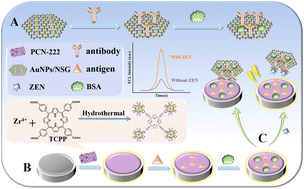Electrochemiluminescence resonance energy transfer immunoassay based on a porphyrin metal–organic framework and AuNPs/NSG for the sensitive detection of zearalenone†
Abstract
In this study, a novel electrochemiluminescence resonance energy transfer (ECL-RET) immunoassay was developed for the first time for the detection of zearalenone (ZEN). A porphyrin metal–organic framework (PCN-222), an emerging porphyrin-based ECL luminophore, was prepared by a simple hydrothermal method using tetrakis(4-carboxyphenyl) porphyrin, which has excellent ECL emission as well as good ECL efficiency. Because the ECL emission spectrum of PCN-222 is highly matched to the absorption spectrum of gold nanoparticle-modified graphene oxide (AuNPs/NSG) nanocomposites, they were used as donor–acceptor counterparts in this work for the ECL-RET strategy. Under optimal conditions, the ECL immunosensor showed a sensitive response to ZEN in a wide detection range, with a linearity of 0.0005–1000 ng mL−1 and a detection limit of 0.15 pg mL−1. In addition, the sensor showed good potential for application in the detection of wheat and corn samples, providing a new approach for the detection of mycotoxin-like contaminants such as ZEN in food grains.



 Please wait while we load your content...
Please wait while we load your content...